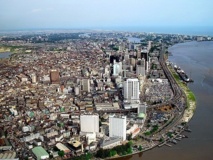Raucous Nigeria's blossoming art scene tweaks the powerful
Ben Simon
LAGOS, Ben Simon- With a champagne flute pressed between his fingers, the Nigerian oligarch stares out with a self-satisfied grin on his bulbous face, not bothered by the desperate masses behind him.
Artist Wande George said the inspiration for the painting, called "The Ruling Class", is visible everyday in the posh Lagos district of Victoria Island where his work was recently displayed.

Author of picture: Jrobin08. Accessed via Wikipedia: http://en.wikipedia.org/wiki/File:Lagos,_Nigeria_57991.jpg.
Its richest sometimes cruise in chauffeur-driven 4X4 vehicles and sleep in ostentatious mansions, while its teeming poor crowd into slums and eke out a living where they can.
But such inequality and adversity can spawn provocative and creative work, and Nigeria is certainly contributing its share.
"We deal with it," said artist Joseph Eze, whose work has explored the destruction of slums that have forced poor residents to abandon their homes, among other issues. "Otherwise, we would have just gone to ashes."
Visual art, including with a political bent, appears to be blossoming here, particularly with stifling military rule having come to an end in 1999 -- though the famously raucous country was hardly culturally mute when it was led by soldier-dictators.
Nigerians such as late afrobeat musician Fela Kuti and Nobel literature prize winner Wole Soyika have long made their mark with politically focused work. Many painters and other visual artists working today are carrying the same torch.
"Local artists are looking more and more at how to express themselves," said Marc-Andre Schmachtel of Germany's Goethe Institute cultural organisation, one of the judges at a recent national art competition in Nigeria.
"People are thinking outside the box now. Already from last year to this year, the level of competition has improved a lot," he added, attributing the progress to changes in Lagos.
The sprawling city, despite being one of the world's most chaotic, has in some ways become an easier place to pursue creative work, with its slowly growing middle class and growing number of art venues.
George, 50, told AFP that several of the pieces in his Re-Emergence series were inspired by the tawdriness with which some flaunt their wealth in a city where much of the roughly 15-million population is extremely poor.
-- 'Nameless, overstuffed aristocrat' --
Of the nameless, overstuffed aristocrat in the portrait, George said, "he doesn't care about the people around him."
His work was exhibited at a trendy Lagos complex that includes a small gallery, a pricey restaurant serving a full range of local dishes, a library and stage venue that hosts theatrical and musical performances.
At the national competition hosted at a conference centre overlooking the Lagos lagoon, Eze, one of the finalists, used the foam from flip-flop sandals that he found discarded on a beach to assemble a large panorama showing the effects of urban development on slum residents.
Eze said he was seeking to chastise the powerful interests whose construction plans have forced thousands to leave their homes, including a recent case at a water-top slum built on stilts in Lagos.
The piece also saluted the ability of impoverished Nigerians to manage the adversity heaped on them by powerful interests, the 38-year-old artist explained.
Not all the finalists were pre-occupied by the hardships inflicted on the poor by the powerful
Alafuro Sikoki, 32, who won the $9,500 second prize, said her work is partly aimed at forcing Nigerians to confront the worrying traits that many here have accepted as normal.
Her 2012 prize-winning conceptual work "Cog" offered a theory to explain the immense popularity of the country's Nollywood films, where outlandish plots, maximum drama and very, very loud performances are the rule.
Nollywood, she suggested, serves a "confessional" role in a country where many have suffered devastating trauma, but where discussing such incidents is often taboo.
"We don't really talk about things," she said. "Really horrible things have happened to people or their families and the only way for them to know that it's not crazy or strange is to experience it on TV as well."
This focus on concrete, modern issues is part of a trend emerging among many young Nigerian artists, who increasingly "reject any form of exoticism and Africanism" that many of their predecessors sought to highlight, said Eve Therond, a New York based artist and competition judge.
Of late, "Lagos has certainly drawn the attention of international curators and collectors," she added.
One of Sikoki's pieces, called "African Time," featured a series of clocks set to different hours that criticised Nigerians' propensity to arrive for appointments whenever they please.
"Why do we perceive time differently than everybody else?" she said. "We're not on the moon!"
----------------------------------------------------------------------------------------------------